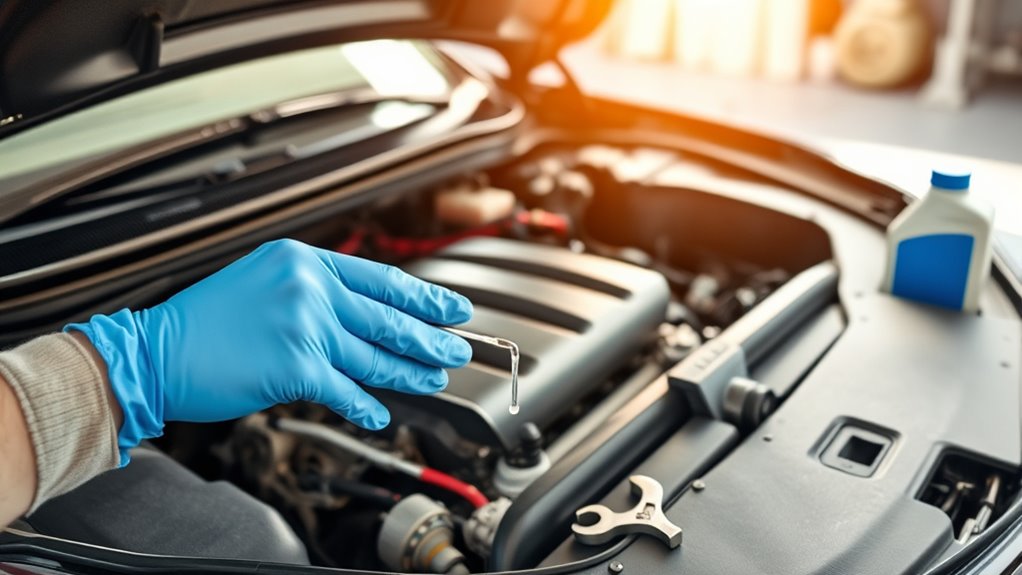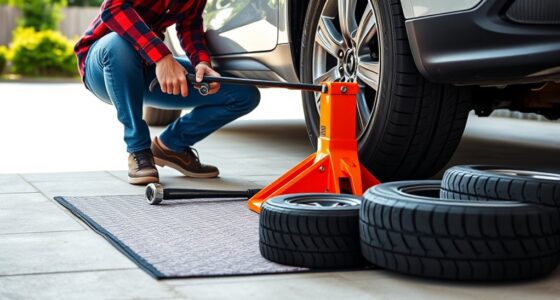To perform a simple tune-up at home, start by inspecting your car’s battery for corrosion and testing its voltage. Check tire pressure and inflate to the recommended level. Examine your air filter—replace it if it looks dirty or clogged. Remove and inspect your spark plugs, replacing any that are worn or dirty. These basic steps help keep your vehicle running smoothly; keep going to discover even more easy maintenance tips.
Key Takeaways
- Check and clean the battery terminals, then test voltage to ensure proper electrical function.
- Inspect and replace worn or dirty spark plugs for smooth engine performance.
- Examine tire pressure and inflate to recommended levels for safety and efficiency.
- Replace or clean the air filter to improve engine power and fuel economy.
- Regularly test the battery and replace if voltage is significantly low to prevent breakdowns.

Performing a simple tune-up at home is a great way to keep your vehicle running smoothly and save money on costly repairs. One of the first things you should check is your car battery. A weak or failing battery can leave you stranded, especially during colder months. Start by inspecting the battery terminals for corrosion or loose connections. If you notice any buildup of white or blueish deposits, disconnect the terminals and clean them with a mixture of baking soda and water, then tighten them securely. Also, consider testing your battery voltage with a multimeter—aim for around 12.6 volts when the engine is off. If your readings are *considerably* lower, it might be time to replace the battery before it dies unexpectedly. Regularly inspecting your car battery *assures* reliable starts and prevents inconvenient breakdowns.
Check your car battery regularly to prevent breakdowns and ensure reliable starts.
Adding to this, battery testing and replacement can help you avoid unexpected failures and ensure your vehicle’s electrical system remains functional.
Next, take a moment to check your tire pressure. Properly inflated tires improve fuel efficiency, extend tire life, and enhance safety. Use a reliable tire pressure gauge to measure each tire’s pressure, including the spare. Refer to your vehicle’s owner’s manual or the sticker inside the driver’s door jamb for the recommended psi. If any tire is underinflated, add air until it reaches the proper level—don’t forget to recheck after filling. Overinflated tires can cause a rough ride and uneven tire wear, so adjust accordingly. Keeping your tires at the correct pressure not only saves you money on fuel but also reduces the risk of blowouts or accidents. It’s a simple step that makes a big difference in your vehicle’s performance.
Once you’ve checked the battery and tire pressure, move on to inspecting and replacing your air filter if needed. A dirty air filter restricts airflow to the engine, decreasing efficiency and power. Remove the filter and hold it up to a light—if you can’t see through it clearly, it’s time for a replacement. Installing a new filter is straightforward and usually inexpensive, but it can *substantially* improve your engine’s performance.
Finally, consider inspecting your spark plugs for wear or carbon buildup. Remove one spark plug at a time and examine the electrode. If the plug is covered in soot, worn out, or has a gap larger than specifications, replace it. Properly functioning spark plugs ensure smooth engine operation and better fuel economy. Performing these simple maintenance tasks at home requires minimal tools and can extend your vehicle’s lifespan, boost safety, and save you money. Regular check-ups like these keep your vehicle in top shape and help catch potential issues early before they become costly repairs.
Frequently Asked Questions
How Often Should I Perform a Car Tune-Up at Home?
You should perform a car tune-up at home every 30,000 miles or every 12 months, whichever comes first. During this, you’ll want to change the oil, replace the spark plugs, and check the air filter. Regular tune-ups keep your engine running smoothly, improve fuel efficiency, and prevent costly repairs. Keep an eye on your vehicle’s maintenance schedule and don’t skip these essential steps for peak performance.
What Tools Are Essential for a Basic Home Tune-Up?
Think of your toolbox as your trusted toolkit for victory. You’ll need basic tools like a wrench, screwdrivers, pliers, and a socket set to tackle essential tasks. Don’t forget safety gear—gloves, safety glasses, and a mask—to protect yourself during the process. These items are your shield and sword, empowering you to perform a home tune-up confidently and safely, ensuring your car runs smoothly for miles ahead.
Can I Perform a Tune-Up on My Own if I’M a Beginner?
Yes, you can perform a tune-up on your own as a beginner with some DIY maintenance and basic tools. Start with simple tasks like changing filters, inspecting belts, and checking fluid levels. Follow beginner tips such as consulting your vehicle’s manual and watching instructional videos. Take your time, stay organized, and don’t hesitate to ask for help if needed. With patience, you’ll gain confidence and keep your vehicle running smoothly.
How Do I Know if My Car Needs a Tune-Up?
You might notice your car struggling to start or experiencing rough idling—that’s a clear sign it needs a tune-up. Check your maintenance intervals; if it’s been a while, a tune-up could be overdue. Diagnostic indicators like decreased fuel efficiency, stalling, or engine misfires also point to needed maintenance. Don’t ignore these signs—they could lead to bigger problems down the road, so stay alert and keep your vehicle in good shape.
Are There Risks Involved in Doing a Tune-Up Myself?
Yes, there are risks involved in doing a tune-up yourself. You might compromise car engine safety if you don’t follow proper procedures or use the wrong parts. DIY repair risks include accidental damage to engine components or injury from tools. If you’re unsure or inexperienced, it’s safer to consult a professional. Always prioritize safety, follow instructions carefully, and know your limits to avoid costly mistakes or accidents.
Conclusion
A simple tune-up is like tending to a garden—you nurture and care for it regularly, and it thrives. By performing this routine maintenance at home, you’re planting seeds of reliability and trust in your vehicle’s future. Remember, just as a gardener’s diligence preserves beauty, your consistent efforts keep your car running smoothly. Embrace this small act as a symbol of your care and responsibility, ensuring your journey remains steady and bright ahead.









